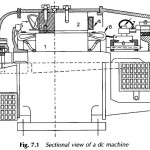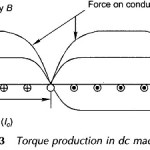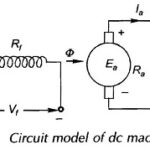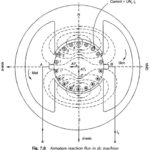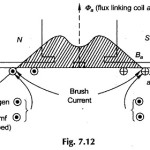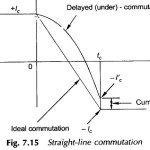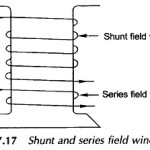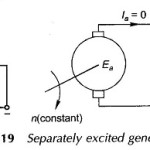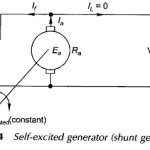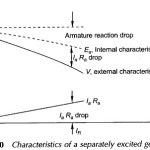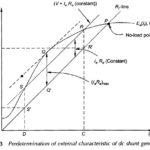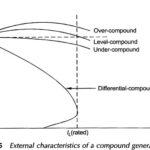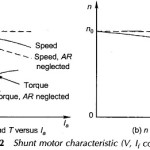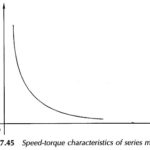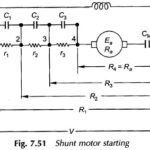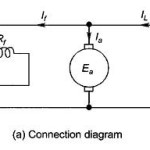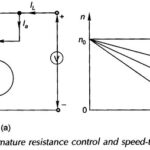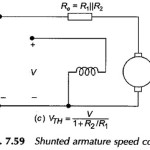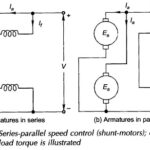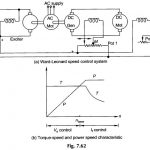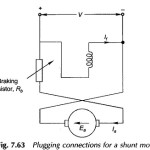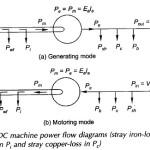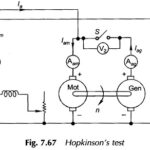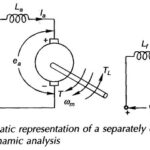DC Machines Articles:
Introduction of DC Motor: Introduction of DC Motor is constructed in many forms and for a variety of purposes, from the 3-mm stepper drawing a few μA at 1.5 V in a quartz crystal watch to the giant 75000-kW or more … (Read More)
EMF and Torque Equation of DC Machine: EMF and Torque Equation of DC Machine – It was shown in Sec. 5.2 (Fig. 5.14 (a)) that in a dc machine the magnetic structure is such that the flux density wave in the … (Read More)
Circuit Model of DC Machine: The parallel paths of DC machine armature are symmetrical and each has an induced emf Ea and a resistance Rp. The armature can be represented by the Circuit Model of DC Machine with voltage Ea and a … (Read More)
Armature Reaction in DC Machine: When the armature of a dc machine carries current, the distributed armature winding produces its own mmf (distributed) known as armature reaction in DC Machine. The machine air-gap is now acted upon by the resultant mmf … (Read More)
Compensating Winding in DC Machine: Compensating Winding in DC Machine – It was seen from earlier section, that armature reaction causes the flux density wave to be so badly distorted that when a coil is passing through the region of peak … (Read More)
Commutation in DC Machine or Generator or Motor: One coil each under an adjoining pole-pair is connected between adjacent commutator segments in a lap-wound dc armature, while in a wave-wound armature the only difference is that P/2 coils under the influence … (Read More)
Methods of Excitation of DC Generator: The performance characteristics of a dc machine are greatly influenced by the way in which the field winding is excited with direct current. There are two Methods of Excitation of DC Generator. Shunt excitation: Here the … (Read More)
Magnetization Characteristics of DC Generator: The emf and torque equations, and power balance has been considered so far. The consideration of the Magnetization Characteristics in this section will set the stage for determining the performance of dc machines. Figure 2.3 depicted the … (Read More)
Self Excited DC Generator: Rather than arranging a separate dc source for excitation purposes, practical generators are always excited from their own armature terminals, this method of excitation being known as Self Excitation. A Self Excited DC Generator with connection as … (Read More)
Characteristics of Separately Excited DC Generator: With the advent of silicon-controlled rectifiers, the importance of the dc machine as a generator has considerably reduced as SCRs can be employed to draw dc power from standard ac supply and convert it to … (Read More)
External Characteristics of DC Shunt Generator: The External Characteristics of DC Shunt Generator can be predetermined from a knowledge of the OCC and armature and field resistances (which can be determined by simple dc test), without actually performing the load test … (Read More)
External Characteristics of Compound Generator: External Characteristics of Compound Generator – The causes of voltage drop in the terminal voltage from no-load to full-load in a shunt generator can be partially/fully/over-compensated by use of an aiding series field (cumulative compound), which … (Read More)
Characteristics of DC Motors | Characteristics of Shunt Motor: The power of the dc motor lies in its versatility and ease with which a variety of speed-torque characteristics can be obtained, and the wide range of speed control which is possible … (Read More)
Speed Torque Characteristics of DC Series Motor: To find the Speed Torque Characteristics of DC Series Motor, let us analysis the figure 7.43 shows the connection diagram of a dc series motor. The speed for this motor is and the torque equation … (Read More)
Starting of DC Motors: At the time of Starting of DC Motors (n = 0), the induced emf of a motor is zero such that the current drawn from rated voltage supply would be for a shunt motor. The series field resistance … (Read More)
Field Control Method of DC Shunt Motor: The Field Control Method of DC Shunt Motor are in general much more adaptable speed drives than ac motors which are associated with a constant-speed rotating field. Indeed one of the primary reasons for … (Read More)
Armature Control Method: The main requirement of this Armature Control Method scheme is a variable voltage supply to the armature whose current rating must be somewhat larger than that of the motor. It is superior to the field control scheme in … (Read More)
Rheostatic Control Method: Rheostatic Control Method – Series armature-resistance control : Here the applied armature voltage is varied by placing an adjustable resistance Re in series with the armature as shown in Fig. 7.58 along with the speed-torque characteristics. Some of the … (Read More)
Shunted Armature Speed Control: Shunted Armature Speed Control – It is a variation of rheostatic control. As is obvious from Fig. 7.59, the principle used in achieving control is that of voltage division. In the shunt motor armature control circuit of Fig. … (Read More)
Series Parallel Control of DC Motor: Series Parallel Control of DC Motor – Here two identical motors are coupled together mechanically to a common load. Two speeds at constant torque are possible in this method one by connecting the motors armatures … (Read More)
Ward Leonard Method of Speed Control of DC Motor: Ward Leonard Method of Speed Control of DC Motor is combined armature and field control and is therefore, operationally the most efficient method of speed control with a wide range. The dc … (Read More)
Braking of DC Motors: Controlled slowing or stopping of a motor and its driven load is as important as starting in many applications (e.g. cranes, traction on a slope to avoid excessive speed, etc.). Braking of DC Motors methods based on … (Read More)
Testing of DC Machine or Swinburne Test: Testing of DC Machine or Swinburne Test – Machine efficiency, in general, has been discussed already. The approach here will be to apply the general principles for the specific case of dc machines. The … (Read More)
Hopkinsons Test on DC Machine: This is a regenerative test in which two identical dc shunt machines are coupled mechanically and tested simultaneously. One of the machines is made to act as a motor driving the other as a generator which … (Read More)
Separately Excited DC Motor for Dynamic Analysis: Separately Excited DC Motor for Dynamic Analysis – The DC machines are quite versatile and are capable of giving a variety of V-A and speed-torque characteristics by suitable combinations of various field windings. With … (Read More)
DC Machine Applications: Whenever the application of any machine is considered, its operating characteristics along with its economic and technical viability as compared to its competitors are the essential criteria. For a DC Machine Applications, of course, the main attraction lies … (Read More)
